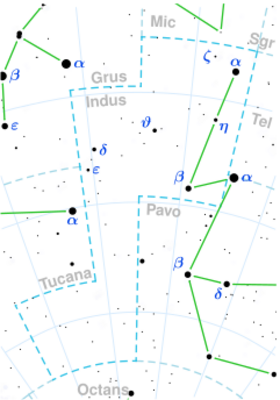Astronomy:Eta Indi
| Observation data Equinox J2000.0]] (ICRS) | |
|---|---|
| Constellation | Indus |
| Right ascension | 20h 44m 02.33404s[1] |
| Declination | −51° 55′ 15.4970″[1] |
| Apparent magnitude (V) | 4.52[2] |
| Characteristics | |
| Spectral type | A9IV[3] |
| B−V color index | +0.26[2] |
| Astrometry | |
| Radial velocity (Rv) | −1.6±0.8[4] km/s |
| Proper motion (μ) | RA: +155.80[1] mas/yr Dec.: −53.86[1] mas/yr |
| Parallax (π) | 41.37 ± 0.25[1] mas |
| Distance | 78.8 ± 0.5 ly (24.2 ± 0.1 pc) |
| Absolute magnitude (MV) | 2.59[5] |
| Details | |
| Mass | 1.60[6] M☉ |
| Radius | 2.27[7] R☉ |
| Luminosity | 7.60[5] L☉ |
| Temperature | 7,694[6] K |
| Rotational velocity (v sin i) | 75[8] km/s |
| Age | 100±50[7] Myr |
| Other designations | |
| Database references | |
| SIMBAD | data |
Eta Indi, Latinised from η Indi, is a single, white-hued star in the southern constellation Indus. It is a faint star but visible to the naked eye with an apparent visual magnitude of 4.52.[2]
Measurements with the Hipparcos spacecraft showed the star, which is single,[9] appears to move against the deep sky backdrop by a mean biannual parallax shift of around 41.37 mas,[1] which equates to 79 light-years' distance. Its radial vector to our system's own trajectory (radial velocity) shows it to be in a phase of a narrowing of the gap, at a rounded −2 km/s, net.[4] η Indi appears to be a member of the Octans association, a group of 62 stars that are around 30−50 million years old and have common motion.[10]
The spectrum of this star matches a stellar classification of A9 IV[3] which suggests it is an evolving subgiant star of type A. The star is estimated 1.6 M☉ (masses of the Sun),[6] and 2.27 R☉ (its radius).[7] It is shines with 7.60[5] times the Sun's luminosity, which is radiated from its photosphere at an effective temperature of 7,694 K.[6] The star is spinning with a projected rotational velocity of 75 km/s.[8] It is very likely to be a hybrid Delta Scuti/Gamma Doradus variable.[8]
References
- ↑ 1.0 1.1 1.2 1.3 1.4 1.5 van Leeuwen, F. (2007). "Validation of the new Hipparcos reduction". Astronomy and Astrophysics 474 (2): 653–664. doi:10.1051/0004-6361:20078357. Bibcode: 2007A&A...474..653V. http://www.aanda.org/articles/aa/full/2007/41/aa8357-07/aa8357-07.html. Vizier catalog entry
- ↑ 2.0 2.1 2.2 2.3 "Eta Indi". SIMBAD Astronomical Database. http://simbad.u-strasbg.fr/sim-id.pl?protocol=html&Ident=Eta+Indi. Retrieved 2016-08-23.
- ↑ 3.0 3.1 Gray, R. O. et al. (July 2006). "Contributions to the Nearby Stars (NStars) Project: spectroscopy of stars earlier than M0 within 40 pc-The Southern Sample". The Astronomical Journal 132 (1): 161–170. doi:10.1086/504637. Bibcode: 2006AJ....132..161G.
- ↑ 4.0 4.1 Gontcharov, G. A. (November 2006). "Pulkovo Compilation of Radial Velocities for 35 495 Hipparcos stars in a common system". Astronomy Letters 32 (11): 759–771. doi:10.1134/S1063773706110065. Bibcode: 2006AstL...32..759G.
- ↑ 5.0 5.1 5.2 Anderson, E.; Francis, Ch. (May 2012). "XHIP: An extended hipparcos compilation". Astronomy Letters 38 (5): 331–346. doi:10.1134/S1063773712050015. Bibcode: 2012AstL...38..331A. Vizier catalog entry
- ↑ 6.0 6.1 6.2 6.3 David, Trevor J.; Hillenbrand, Lynne A. (May 2015). "The Ages of Early-type Stars: Strömgren Photometric Methods Calibrated, Validated, Tested, and Applied to Hosts and Prospective Hosts of Directly Imaged Exoplanets". The Astrophysical Journal 804 (2): 146–184. doi:10.1088/0004-637X/804/2/146. Bibcode: 2015ApJ...804..146D. Vizier catalog entry
- ↑ 7.0 7.1 7.2 Plavchan, Peter et al. (June 2009), "New Debris Disks Around Young, Low-Mass Stars Discovered with the Spitzer Space Telescope", The Astrophysical Journal 698 (2): 1068–1094, doi:10.1088/0004-637X/698/2/1068, Bibcode: 2009ApJ...698.1068P.
- ↑ 8.0 8.1 8.2 Koen, C.; van, Wyk F.; Laney, C. D.; Kilkenny, D. (2017), "HR 7920: a very bright new Delta Scuti star with possible Gamma Doradus variations", MNRAS 466 (1): 122–128, doi:10.1093/mnras/stw3062, Bibcode: 2017MNRAS.466..122K
- ↑ Rodriguez, David R. et al. (May 2015), "Stellar multiplicity and debris discs: an unbiased sample", Monthly Notices of the Royal Astronomical Society 449 (3): 3160–3170, doi:10.1093/mnras/stv483, Bibcode: 2015MNRAS.449.3160R.
- ↑ Torres, C. A. O.; Quast, G. R.; da Silva, L .; de la Reza, R.; Melo, C. H. F.; Sterzik, M. (2006). "Search for associations containing young stars (SACY)". Astronomy and Astrophysics 460 (3): 695–708. doi:10.1051/0004-6361:20065602. ISSN 0004-6361. Bibcode: 2006A&A...460..695T.
 |


